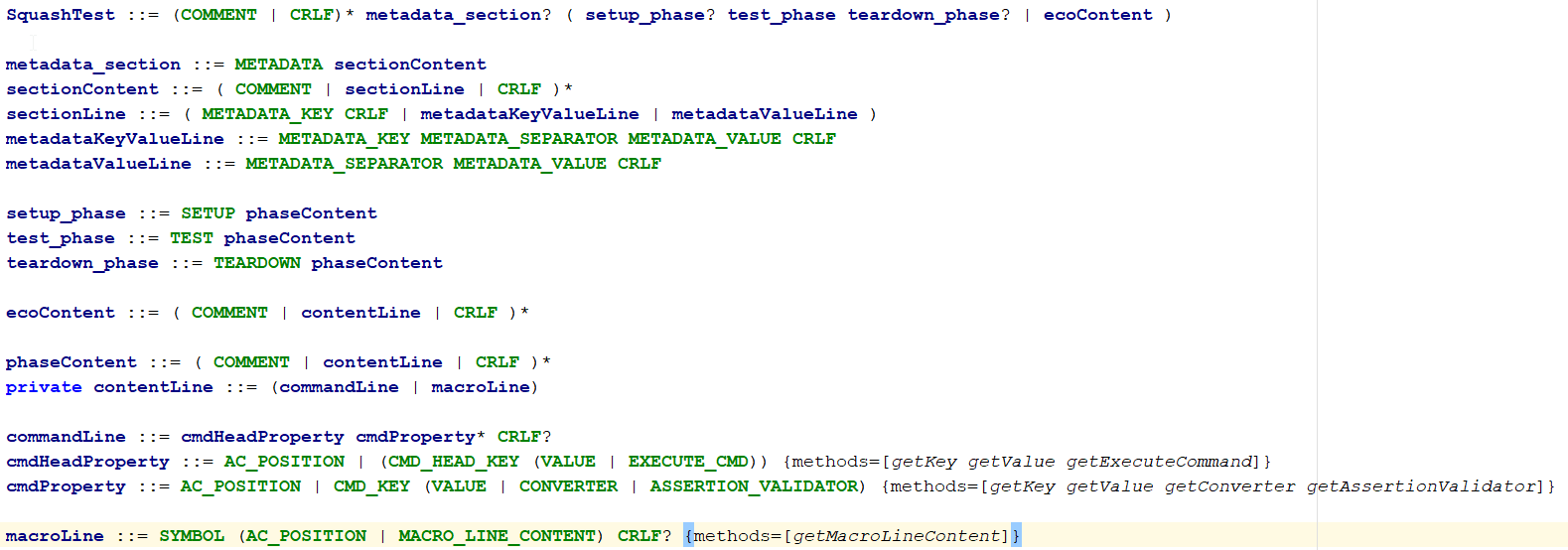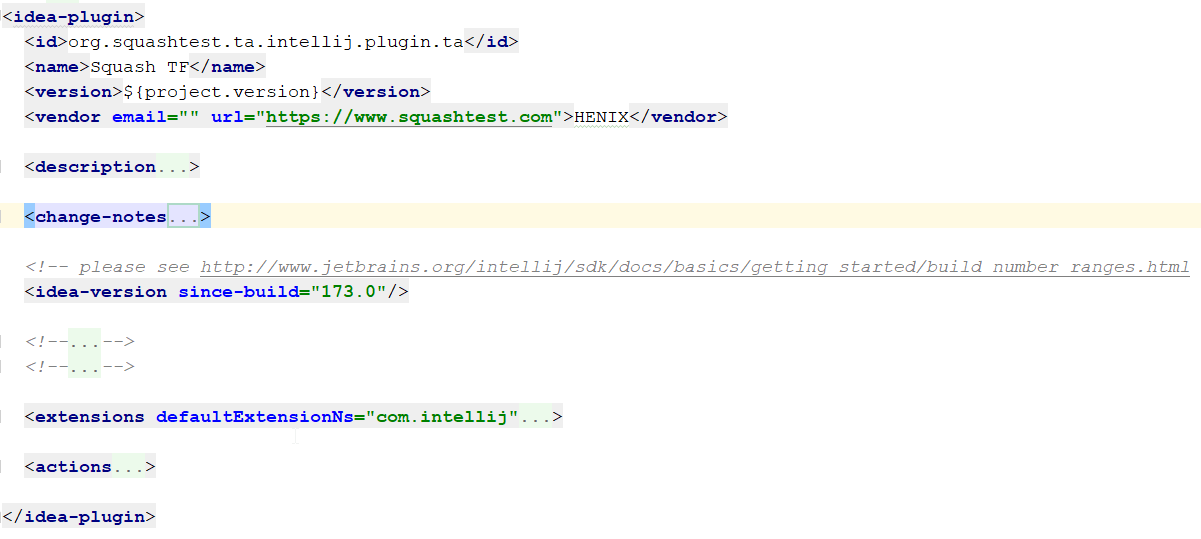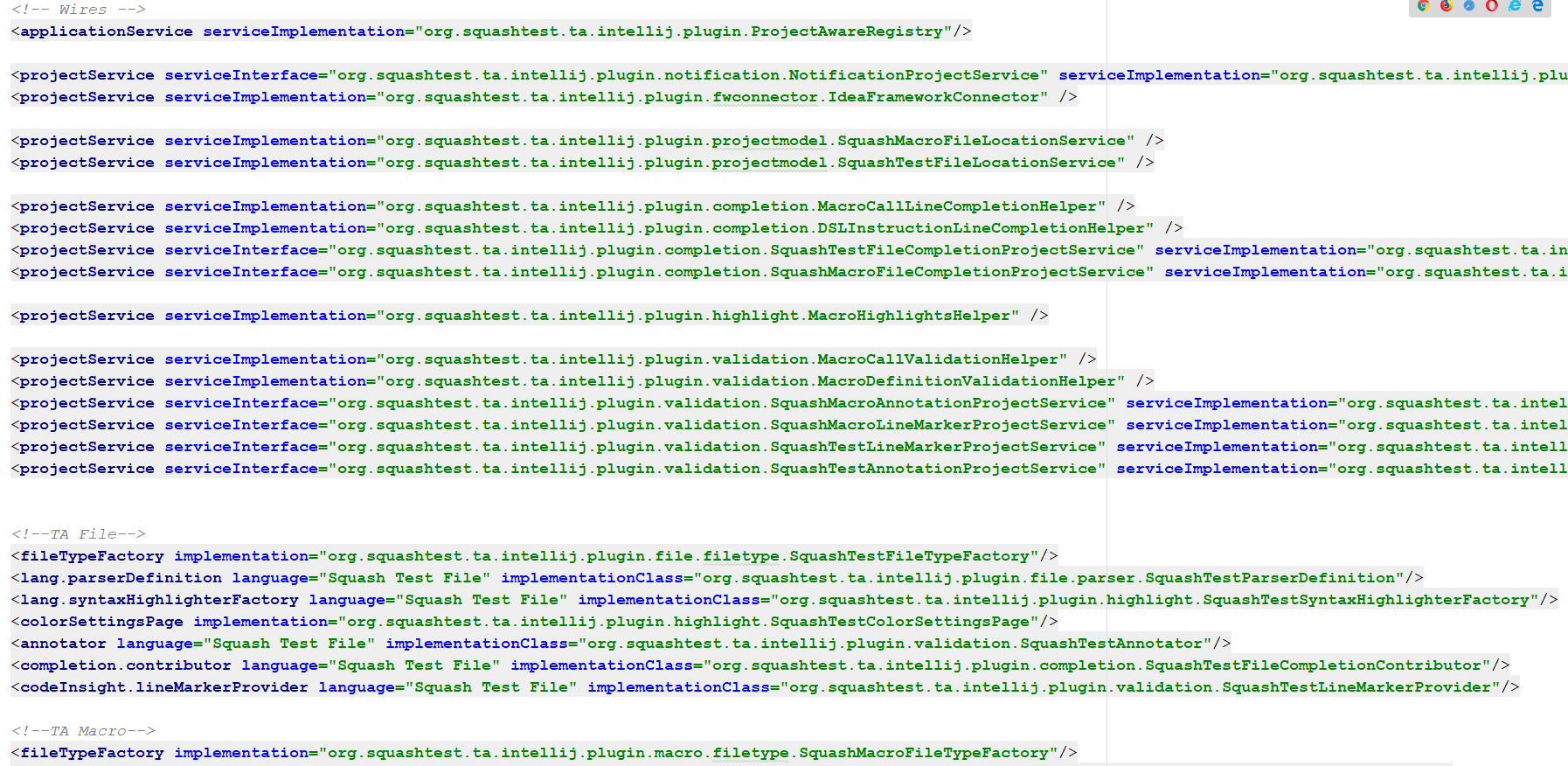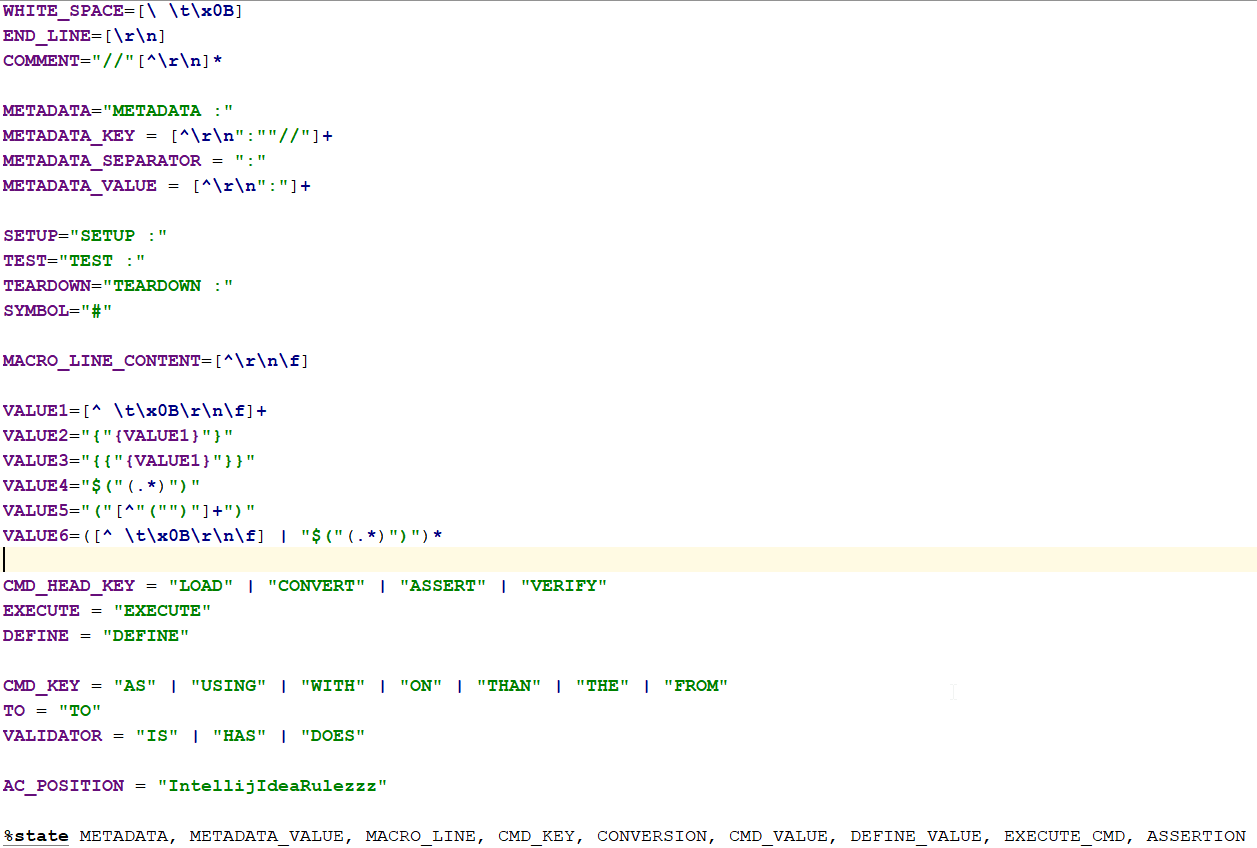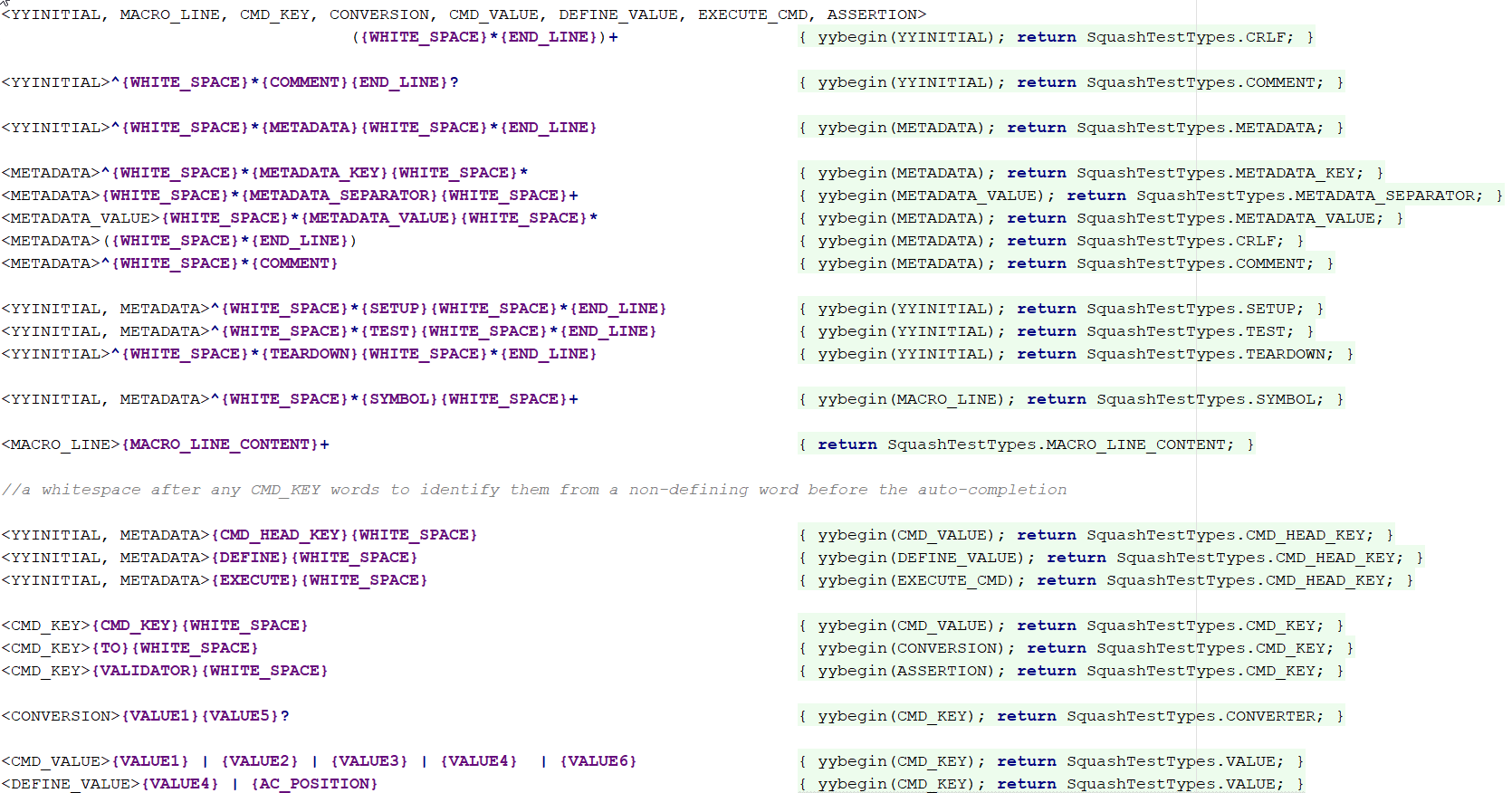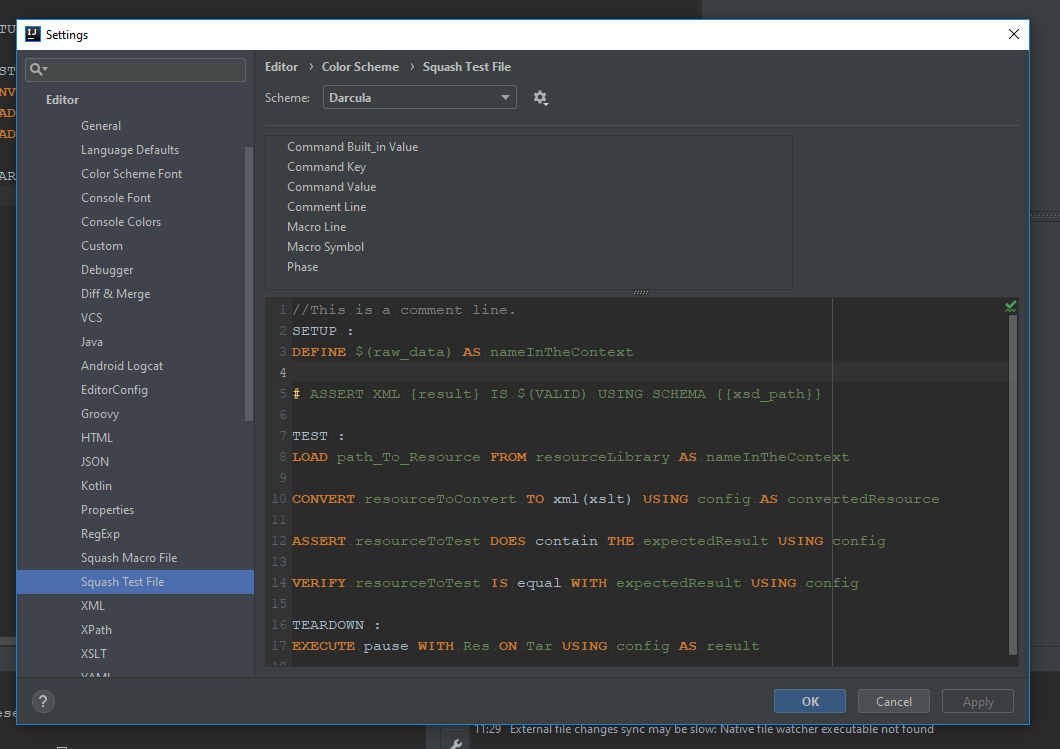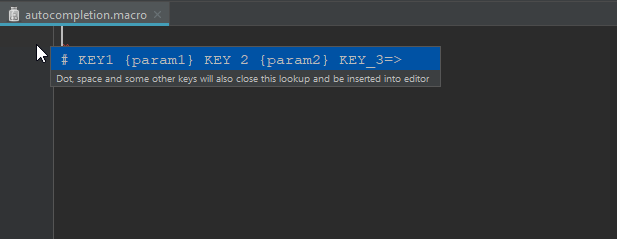Squash TF IntelliJ IDEA plugin¶
Guide for Plugin Functional Development¶
Introduction¶
1. Purpose¶
This document is a Technical Design Document for use by IntelliJ-Squash-plugin project. It provides not only a global view on the infra-structure between the project modules, but also the technical/functional analysis onto each feature of the plugin project.
2. Intended audience¶
- Supervisors, to analyse the design and implementation of the plugin project
- Squash TF team members
- Future developers, testers who will work with the plugin
3. Scope¶
This document describes the structure design and the technical analysis of IntelliJ-Squash-plugin project.
4. Acronyms¶
| Acronym | Definition |
|---|---|
| BNF | Backus-Naur Form |
| DSL | Domain Specific Language |
| IDE | Integrated Development Environment |
| ISP | IntelliJ-Squash-plugin |
| SKF | Squash Keyword Framework |
System overview¶
The ISP project is a member of the Squash TF galaxia project group which is open-source but belongs to @Henix company.
While the whole group purpose is to provide to grand public a toolbox for functional testing automation and is dedicated to the industrialization of automated test execution, the goal of the ISP itself is to allow users (i.e. developers, testers…) to compose, execute or even test SKF DSL via IntelliJ Community IDE.
This plugin project consists of 5 modules:
- IntelliJ-Idea Platform: creates all dependencies in the IntelliJ-idea binaries to be used as provided dependencies for the build and packaging of the Intellij reactor.
- IntelliJ-Idea Platform Bundle: allows the packaging of the IntelliJ-Idea platform dependencies for CI builds and development environment.
- Squash Keyword Framework Parser for IntelliJ-Idea: parse the SKF DSL elements into IntelliJ PsiElements for plugin feature development.
- Intellij-jflex-adapter: creates an adapter for the version 1.7.0-2 of flex created by Jetbrains for IntelliJ Community IDE, in order to use it with the jflex plugin.
- Squash Keyword Framework Plugin for IntelliJ-Idea: provides all kinds of features for SKF DSL in IntelliJ Community IDE such as: autocompletion, syntax annotation/coloration…
Technical requirement¶
As ISP is a Maven project dedicated to create an IntelliJ IDE plugin, it is required in local:
- JAVA JDK 1.8+
- MAVEN (3.5.0 recommended)
Warning
The Maven path MUST contain no spaces to avoid installation problems.
- IntelliJ Community IDE (version from 2018.3.2 to 2019.1.x)
- Git for cloning the IntelliJ project code sources (version 2018.3.2 Build #IC-183.4886.37)
PS: The document for setting an environment for the ISP development can be obtain here
Plugin component descriptions¶
1. IntelliJ-Idea Platform¶
To be updated…
2. IntelliJ-Idea Platform Bundle¶
To be updated…
3. Squash Keyword Framework Parser for IntelliJ-Idea¶
This is the core of the SKF DSL parsing process in IntelliJ Community IDE. In fact, it helps the IDE not only to identify whether or not a file belongs to a DSL (ex: .ta, .macro) but as well to check if that file content complies with all those DSL syntax conventions.
This module consists of 2 principal packages:
src/main/bnf: contains all BNF files of the ISP.
As known by its name, each BNF file is a formal notation for encoding grammars intended for human consumption. More detailed information about BNF can be found here.
There are two BNF files of SKF DSLs used in the ISP.
The elements in green color is of type simple. Their value is defined by a Lexer file that will be discussed in the next chapters of this document.
The elements in blue color is of type complex. Their value is composed of more than one simple or other complex elements.
Each element here will then be generated into a specific JAVA class called IntelliJ PsiElement class which is later used for the ISP features development.
Warning
As a file violates one or more BNF specifications, the first-found-troublemaker element will be annotated as ERROR.
This ERROR will disable any plugin functionality for the rest of the file.
Moreover, it also blocks all possible development interventions as no more IntelliJ PsiElement could be identified.
Hint
It is therefore strongly advised to have a discussion between the plugin developers and product owner before inserting or removing a syntax convention at this PARSING level.
src/main/java:
This package contains JAVA classes that helps IntelliJ Community IDE to identify a file’s language by its extension.
It also creates Element-type and Token-type ofr a DSL, as well as implement methods in order to obtain the value of each PsiElement.
4. Intellij-jflex-adapter¶
To be updated…
5. Squash Keyword Framework Plugin for IntelliJ-Idea¶
This module whose type is IntelliJ Plugin is the base package of the ISP.
Its purpose is to develop all SKF DSL features for IntelliJ Community IDE.
sources/META-INF: contains the plugin.xml file.
This XML file declares the service, the role, as well as the scale (or life-cycle) of JAVA classes created in the following src/main/java package.
The most important part of this file is the service declaration and implementation that indicates which JAVA class takes care of which plugin feature of the ISP.
Note
Syntax convention for this plugin.xml is modified by IntelliJ from version
2019.2.x. More information about this can be found here.src/main/java: consists of all JAVA classes used for the plugin feature development.
There are 9 main sections in this package:
5.1. Project model
This is to defines a model for the SKF project organization in IntelliJ Community IDE as well tools to use it.
To be specific, it checks whenever the current project is a valid SKF DSL project. On the other hand, it helps IntelliJ Community IDE to get the virtual files of all TA File/Macro files in the working project for further development investigations/interactions.
5.2. Framework connector
This module’s goal is to connect the ISP with the SKF DSL framework (squash-ta-new-engine project) to obtain all the engine components such as built-in macros, converters or command…
5.3. Notification
This service controls the notification mechanism in the ISP (the notif. message content, warning level, showing time…).
5.4. Language
All JAVA classes for name, extension, icons, lexer (see
4.5.5 section) and parser of each SKF DSL are defined in this section.5.5. DSL Lexer
Until the project re-structuring is completed, these lexers temporarily locate in the file/lexer/ and macro/lexer/ folders.
IntelliJ Community IDE uses jflex technology to create the lexer for each custom language. In fact, a lexer defines the valid value(s) for every element created by the parser of that DSL. If the current parsed element of a file conforms to the corresponding lexer convention, it will be assigned to an appropriate PsiElement in the ISP.
There are 2 principal steps in every lexer file (.flex):
More detailed information about jflex can be found at this link.
Warning
As in case of parsing process, if a file violates one or more FLEX specifications, the first-found-troublemaker element will be annotated as ERROR.
This ERROR will disable any plugin functionality for the rest of the file.
Moreover, it also blocks all possible development interventions as no more IntelliJ PsiElement could be identified.
Hint
It is therefore strongly advised to have a discussion between the plugin developers and product owner before inserting or removing a syntax convention at this LEXING level.
5.6. Validation
This is one of the 3 main features of the ISP added into IntelliJ Community IDE: defining general validation logic for SKF DSLs.
As you may already know, the first step of validating a file content is provided through each DSL parser and lexer. If passed, that file is then considered of that DSL and then the parsing process in ISP will store each captured item in an appropriate PsiElement object.
This is the second validation step which is to check if this DSL-conformed-file is in the correct directory, if a SKF DSL basic instruction line is 1 of 6 valid templates, if a macro line is well defined or if a metadata input syntax is correct…
Note
The advantage of this validation step is that developer can choose when, where and how to call an error, warn or info message for each case of violation.
In addition to the syntax validation, this section also provides the macro signature/line tracing ability. If a macro signature or a macro line of a file is found in the framework component list or in the project
shortcutsfolder (or its subfolders), a marker will be created at the beginning of that line and eventually provides the navigation to the defining macro file if the latest is in theshortcutsfolder (or its subfolders).5.7. Highlighting
This is second features of the ISP added into IntelliJ Community IDE: providing generic highlight tools for SKF DSLs.
When a file is found in such a DSL by passing that language parsing process, each DSL item of this file will be associated with a corresponding PsiElement element. Those elements are then grouped by type.
This functionality is to assign each element group a specific color for the user visualization.
Besides, it creates also a
color setting pagefor each SKF DSL in IntelliJ Community IDE.5.8. Autocompletion
This is third features of the ISP added into IntelliJ Community IDE: implementing general completion logic for SKF DSLs.
This functionality proposes to user the most appropriate SKF DSL elements based on the current file content and the user cursor position. Each SKF DSL (Squash Test and Squash Macro) has a specific autocompletion mechanism.
Note
The common point of these two mechanisms is that the autocompletion result is at least a SKF DSL element and at most to complete the asking-for-completion line.
5.8.1. Squash Test autocompletion
There are three different kinds of completions in a Squash Test file:
Phase/section completion
When user requests a completion by typing Ctrl+Space, the plugin will firstly check the existence of each phase/section (i.e. METADATA, SETUP, TEST, TEARDOWN) in the current file. If this file is not an Ecosystem file (
setup.taorteardown.ta), the appropriate missing phase(s) will be proposed.Warning
The TEST phase must exist in file content or it is the only result to be proposed for completion.
Line completion
When a phase is already defined and the user cursor is on an empty line, a line completion will be invoked.
In fact, user can choose either 1 of 6 available SKF DSL instruction templates or simply their HEAD KEY to insert an
basic instruction.On the other hand, he/she can get the
#symbol to start amacro line.Element completion
When an autocompletion is asked on a non-empty line, the most appropriate SKF DSL elements will be offered if that line is of type
basic instruction.In case of
macro line, the element completion functionality is not yet available for this ISP version.5.8.2. Squash Macro autocompletion
Similarly, there are also three different kinds of completions in a Squash Macro file:
Macro signature completion
Line completion
Under reconstruction
Element completion
Under reconstruction
5.9. Tools
This is a collection of utils (methods) used for developing the 3 features of the ISP.
